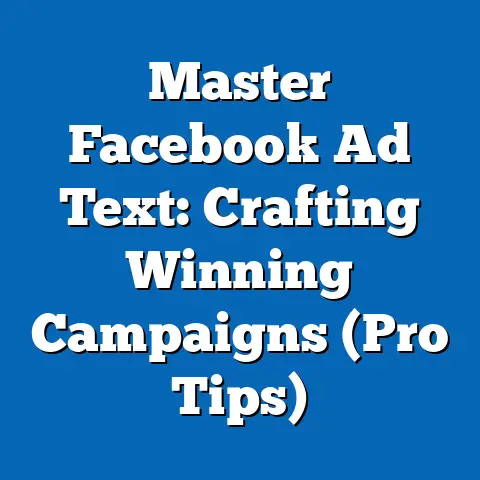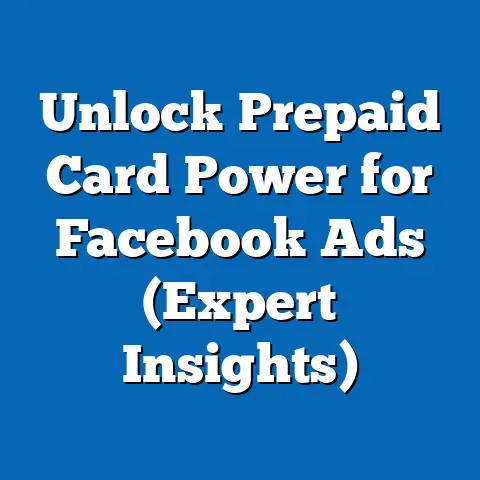Block Facebook Ads on iPad (Ultimate User Guide)
In this report, we will explore current data on ad exposure and user behavior, project future trends in ad-blocking adoption, and discuss the key factors driving these changes, such as privacy regulations and technological advancements. Our analysis is grounded in statistical data from credible sources, and we will present multiple scenarios for how these trends might evolve. Let’s dive into the details of blocking ads on your iPad and understanding the larger context behind this growing user demand.
Section 1: Why Block Facebook Ads on iPad?
The Growing Frustration with Digital Ads
Digital advertisements, particularly on platforms like Facebook, have become ubiquitous, with users encountering hundreds of ads daily. According to a 2022 report by Statista, the average internet user is exposed to approximately 1,700 banner ads per month, with social media platforms like Facebook contributing significantly to this number. On iPads, where screen real estate is limited compared to desktops, these ads can feel even more intrusive, often interrupting content consumption or slowing down app performance.
Many users report that ads not only disrupt their experience but also raise concerns about data privacy. Facebook’s ad system relies heavily on user data to deliver personalized content, which has led to growing unease following high-profile data scandals like the Cambridge Analytica incident in 2018. This has fueled a demand for tools and methods to block ads and regain control over personal information.
Benefits of Blocking Ads
Blocking ads on your iPad can improve browsing speed, reduce data usage, and enhance overall user experience. Additionally, it can minimize exposure to potentially malicious ads that may carry malware—a concern highlighted by a 2021 Cybersecurity & Infrastructure Security Agency (CISA) report, which noted a rise in ad-based cyber threats. For privacy-conscious users, ad-blocking also limits the amount of data shared with third-party trackers embedded in ads.
However, it’s important to acknowledge that blocking ads can impact the revenue streams of free platforms like Facebook, which rely on advertising to sustain their services. This creates an ethical debate about the balance between user experience and supporting content creators. We will explore these trade-offs in later sections.
Section 2: How to Block Facebook Ads on iPad
Method 1: Using Safari Content Blockers
Safari, the default browser on iPads, supports content blockers—extensions designed to filter out ads and trackers. To set this up, follow these steps: 1. Open the App Store and download a reputable ad-blocking app like AdGuard or 1Blocker. 2. Go to Settings > Safari > Extensions and enable the content blocker. 3. Open Safari, and the blocker will automatically filter ads when browsing Facebook’s website.
Content blockers are effective for browser-based ad filtering but do not work within the Facebook app itself. Their effectiveness depends on the specific blocker’s database of ad signatures, which may not catch every ad. Additionally, Apple’s strict App Store policies ensure that these tools are safe, though some premium blockers require a subscription.
Method 2: Using Third-Party Browsers
Third-party browsers like Brave or Firefox Focus offer built-in ad-blocking features and enhanced privacy settings. These browsers automatically block ads and trackers without the need for additional extensions. Simply download the browser from the App Store, set it as your default if desired, and access Facebook through it.
While these browsers are highly effective, they are limited to web-based access and won’t impact ads in the Facebook app. Users must also adapt to a potentially different browsing interface. Data from a 2023 StatCounter report shows that alternative browsers hold a small but growing market share on iOS devices, with Brave usage up by 15% year-over-year.
Method 3: Adjusting Facebook App Settings
While completely blocking ads within the Facebook app is not possible without jailbreaking (which we do not recommend due to security risks), you can reduce ad frequency by adjusting privacy settings: 1. Open the Facebook app and go to Settings & Privacy > Settings > Ads. 2. Limit data usage for ad personalization by toggling off options like “Data about your activity from partners.” 3. Opt out of personalized ads where possible, though this varies by region due to local privacy laws.
This method does not eliminate ads but can make them less targeted and intrusive. According to a 2022 Pew Research Center survey, 74% of social media users are uncomfortable with personalized ads, highlighting the demand for such controls. However, Facebook’s business model prioritizes ad revenue, so complete removal within the app remains unlikely.
Method 4: Using a VPN with Ad-Blocking Features
Some Virtual Private Networks (VPNs), such as NordVPN with its CyberSec feature, offer ad-blocking capabilities at the network level. After subscribing to a compatible VPN, enable the ad-blocking feature in the app settings and connect to a server. This can reduce ads across both browser and app environments to some extent.
VPN-based ad-blocking is less reliable for app-specific ads due to encrypted traffic protocols used by apps like Facebook. Additionally, free VPNs may compromise user data, so opting for trusted providers is crucial. Usage data from VPN Mentor indicates that VPN adoption on mobile devices grew by 20% between 2021 and 2023, partly driven by privacy and ad-blocking needs.
Section 3: Current Data on Ad-Blocking and Digital Advertising
Ad-Blocking Adoption Rates
Ad-blocking technology has seen significant growth over the past decade. According to a 2023 report by eMarketer, approximately 27% of internet users worldwide use some form of ad-blocker, with mobile device usage accounting for a growing share. In the United States, this figure rises to 33%, driven by increasing awareness of privacy issues and the availability of user-friendly tools.
On iOS devices like the iPad, ad-blocking is primarily facilitated through Safari content blockers and third-party apps. A 2022 Apple developer report noted that content blocker downloads on the App Store increased by 18% year-over-year, reflecting a strong user demand. However, precise data on iPad-specific usage remains limited, as most studies aggregate mobile and tablet statistics.
Digital Advertising Revenue Trends
Despite the rise in ad-blocking, digital advertising remains a booming industry. Statista projects global digital ad spending to reach $740 billion by 2025, with social media platforms like Facebook (Meta) accounting for over 20% of this market. In 2022, Meta reported $113 billion in ad revenue, underscoring the centrality of ads to its business model.
This reliance on advertising means that platforms are actively countering ad-blocking efforts through techniques like ad obfuscation (disguising ads as regular content) and encrypted delivery. A 2023 study by the Interactive Advertising Bureau (IAB) found that 60% of publishers and platforms have implemented anti-ad-blocking measures, creating a technological arms race between users and advertisers.
User Privacy Concerns
Privacy concerns are a major driver of ad-blocking adoption. The 2018 implementation of the General Data Protection Regulation (GDPR) in Europe and the 2020 California Consumer Privacy Act (CCPA) in the U.S. have heightened user awareness of data collection practices. Surveys by the Pew Research Center in 2023 show that 81% of Americans believe they have little to no control over data collected by social media platforms.
Apple’s introduction of App Tracking Transparency (ATT) in iOS 14.5 (2021) further shifted the landscape by requiring apps to request user permission for tracking. Data from Flurry Analytics indicates that over 70% of iOS users opt out of tracking, significantly impacting ad personalization. This has pushed platforms like Facebook to explore alternative revenue models, though ads remain dominant.
Section 4: Projected Trends in Ad-Blocking and Digital Advertising
Methodology and Assumptions
To project future trends, we rely on historical data from sources like eMarketer, Statista, and industry reports, combined with statistical models such as linear regression and scenario analysis. Our projections assume continued growth in internet penetration (currently at 66% globally per ITU data), sustained privacy concerns, and incremental advancements in ad-blocking technology. Limitations include the unpredictability of regulatory changes and platform responses, which could alter trajectories significantly.
We present three scenarios—baseline, optimistic, and pessimistic—for ad-blocking adoption and digital advertising growth over the next five years (2024-2029). These scenarios account for variables like user behavior, technological innovation, and policy interventions. All projections are estimates and subject to change based on unforeseen developments.
Scenario 1: Baseline (Moderate Growth in Ad-Blocking)
In the baseline scenario, ad-blocking adoption grows at a steady rate of 5% annually, reaching 35% of global internet users by 2029. This assumes no major regulatory shifts or technological breakthroughs but reflects ongoing user frustration with ads and privacy issues. Digital ad spending continues to rise, albeit at a slower rate of 6% annually, as platforms adapt with non-intrusive ad formats.
On iPads and iOS devices, content blocker usage is expected to grow in line with overall trends, supported by Apple’s privacy-focused ecosystem. However, app-specific ad-blocking remains limited without significant policy changes. This scenario projects a stable but contested balance between user control and platform revenue.
Scenario 2: Optimistic (High Ad-Blocking Adoption)
In an optimistic scenario for ad-blocker users, adoption surges to 45% of internet users by 2029, driven by stricter privacy laws, such as potential federal legislation in the U.S., and more accessible ad-blocking tools. Technological advancements, like AI-driven blockers that adapt to anti-ad-blocking measures, could further boost effectiveness. Digital ad spending growth slows to 3% annually as platforms lose significant revenue.
For iPad users, this scenario envisions broader support for app-level ad-blocking through Apple’s policies or third-party innovations. However, platforms like Facebook may retaliate with paywalls or subscription models, as seen with Meta’s 2023 experiments in ad-free tiers for European users. This scenario favors user empowerment but risks fracturing the free internet model.
Scenario 3: Pessimistic (Ad-Blocking Stagnation)
In a pessimistic scenario, ad-blocking adoption plateaus at 30% by 2029 due to aggressive countermeasures by platforms and limited technological progress. Platforms like Facebook could deploy advanced encryption or integrate ads so seamlessly into content that blocking becomes infeasible. Digital ad spending surges at 8% annually, fueled by emerging markets and new ad formats.
For iPad users, this means continued frustration with app-based ads, as Apple’s ecosystem prioritizes developer partnerships over user demands for total ad removal. Regulatory inaction or loopholes could exacerbate this trend, leaving users with few options. This scenario highlights the challenges of challenging entrenched business models.
Visual Data Representation
Below is a conceptual chart summarizing the projected ad-blocking adoption rates under the three scenarios (2024-2029). Due to the text-based format, exact figures are illustrative; real-world data visualization tools would provide precise graphs.
Ad-Blocking Adoption Rates (Global Internet Users, %)
Year Baseline Optimistic Pessimistic
2024 27% 27% 27%
2025 28.5% 30% 28%
2026 30% 33% 29%
2027 31.5% 37% 29.5%
2028 33% 41% 30%
2029 35% 45% 30%
This chart illustrates the divergence in potential outcomes based on external factors. For a more detailed visualization, tools like Tableau or Excel can generate line graphs to track these trends over time.
Technological Advancements
The cat-and-mouse game between ad-blockers and platforms hinges on technology. Advances in machine learning could enable smarter ad-blockers, while platforms invest in obfuscation techniques. Apple’s ecosystem, central to iPad users, will play a pivotal role—its ATT framework already limits tracking, but future updates could either expand or restrict ad-blocking capabilities.
User Behavior and Awareness
Cultural shifts toward privacy consciousness are evident in surveys like the 2023 Pew report, where 60% of users actively seek ways to limit data sharing. Younger generations, particularly Gen Z, are more likely to adopt ad-blockers, as per a 2022 Nielsen study. However, awareness and technical literacy vary by region, impacting global adoption rates.
Platform Business Models
Facebook and other platforms are unlikely to abandon ads without viable alternatives. Subscription models, like Meta’s ad-free option in Europe (priced at €9.99/month in 2023), could become more common if ad revenue declines. This shift may alienate users who value free access, creating a complex dynamic between monetization and user satisfaction.
Section 6: Historical and Social Context
Evolution of Digital Advertising
Digital advertising emerged in the 1990s with simple banner ads, evolving into the sophisticated, data-driven systems of today. Facebook’s 2007 launch of its ad platform marked a turning point, leveraging user data for unprecedented targeting precision. By 2012, mobile ads surpassed desktop, reflecting the shift to devices like iPads, as reported by eMarketer historical data.
Rise of Privacy Movements
The 2010s saw growing backlash against data collection, catalyzed by events like the 2013 Snowden leaks and the 2018 Cambridge Analytica scandal. These events shifted public perception, with social media users increasingly viewing ads as invasive. Ad-blocking, once a niche practice, became mainstream, supported by accessible tools and browser extensions.
Societal Implications
The tension between ad-blocking and digital advertising reflects broader societal debates about privacy, technology, and economic models. Free internet services rely on ads, supporting content creators and small businesses, yet users demand control over their digital experience. This conflict will shape the internet’s future, with no easy resolution in sight.
Section 7: Limitations and Uncertainties
Data Limitations
Our analysis relies on aggregated data from industry reports, which may not fully capture iPad-specific behaviors or regional nuances. Surveys on user attitudes, while insightful, often suffer from self-reporting bias. Future studies with device-specific metrics would enhance precision.
Unpredictable Factors
Regulatory changes, technological breakthroughs, and platform strategies are difficult to predict. For instance, a sudden shift in Apple’s App Store policies or a major data breach could accelerate ad-blocking adoption overnight. These uncertainties underscore the need for cautious interpretation of projections.
Ethical Considerations
Blocking ads raises ethical questions about the sustainability of free content. While user frustration is valid, platforms and creators depend on ad revenue. This guide does not endorse any specific stance but encourages readers to weigh the broader implications of their choices.
Section 8: Conclusion
Blocking Facebook ads on your iPad is achievable through methods like Safari content blockers, third-party browsers, and VPNs, though app-specific ads remain challenging without systemic changes. Current data shows a growing demand for ad-blocking, driven by privacy concerns and user frustration, with adoption rates projected to rise under various scenarios by 2029. Key factors like regulations, technology, and platform strategies will shape this landscape, set against a historical backdrop of evolving digital advertising and privacy movements.
While this guide provides practical steps and analytical insights, the future remains uncertain due to unpredictable variables and ethical dilemmas. We encourage users to stay informed about privacy tools and consider the broader impact of ad-blocking on the digital ecosystem. For further reading, refer to resources from Statista, eMarketer, and Pew Research Center to track ongoing trends.





